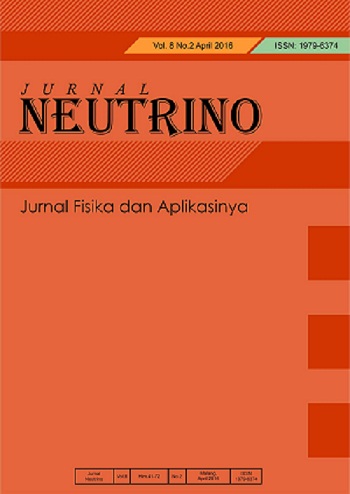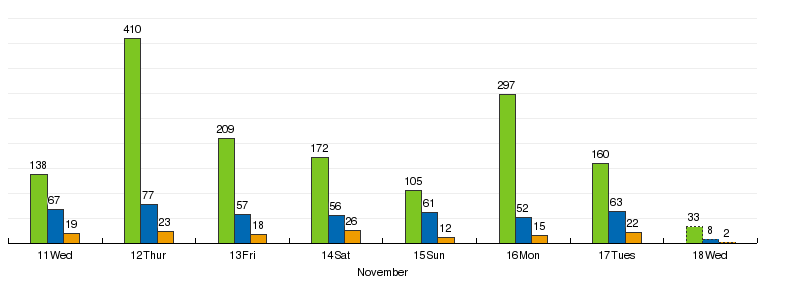ANALYSIS OF ACTIVE LAYER THICKNESS ON THIN LAYER SOLAR CELL PERFORMANCE
Abstract
The main objective of this research is to fabricate double-layer hydrogenated amorphous silicon (a-Si:H) using a PECVD by varying the thickness of the active layer. To obtain the thickness of the double active layer, dilution of silane plasma is carried out by hydrogen, with a ratio of hydrogen and silane, R=H2/SiH4 varies, and the deposition time of the active layer, while the n-type and n-type extrinsic layers are fixed for each -each sample. Then on the sample, there is a metal coating on the back which acts as an electrical contact and light reflector. Additionally, each sample was examined or searched for with a sun simulator and sunlight for physical properties, such as thickness morphology, optical properties, such as bandgap, electrical properties, such as electrical conductivity, and I-V characterization of a-Si: H double active layer solar cells. Based on the I-V characterization of the a-Si: H double active layer solar cells that were found in this work, a satisfactory conversion efficiency (8.86%) was found, although the Field Factor of the active layer was still low. While the intrinsic photo response reached 105
Keywords
Full Text:
PDFReferences
Guha S. Amorphous Semiconductor Solar Cells. In: Buschow KHJ, Cahn RW, Flemings MC, Ilschner B, Kramer EJ, Mahajan S, et al., editors. Encyclopedia of Materials: Science and Technology [Internet]. Oxford: Elsevier; 2001 [cited 2022 Nov 20]. p. 259–63. Available from: https://www.sciencedirect.com/science/article/pii/B0080431526000565
Kasap S, Koughia C, Singh J, Ruda H, OʼLeary S. Optical Properties of Electronic Materials: Fundamentals and Characterization. In: Kasap S, Capper P, editors. Springer Handbook of Electronic and Photonic Materials [Internet]. Boston, MA: Springer US; 2007 [cited 2022 Nov 2]. p. 47–77. (Springer Handbooks). Available from: https://doi.org/10.1007/978-0-387-29185-7_3
Flewitt AJ. Hydrogenated Amorphous Silicon Thin-Film Transistors (a-Si:H TFTs). In: Chen J, Cranton W, Fihn M, editors. Handbook of Visual Display Technology [Internet]. Cham: Springer International Publishing; 2016 [cited 2022 Nov 20]. p. 887–909. Available from: https://doi.org/10.1007/978-3-319-14346-0_47
Prayogi S, Cahyono Y, Darminto D. Electronic structure analysis of a-Si: H p-i1-i2-n solar cells using ellipsometry spectroscopy. Opt Quantum Electron. 2022 Sep 16;54(11):732.
Illiberi A, Kudlacek P, Smets AHM, Creatore M, van de Sanden MCM. Effect of ion bombardment on the a-Si:H based surface passivation of c-Si surfaces. Appl Phys Lett. 2011 Jun 13;98(24):242115.
Rozati SM, Ziabari SAM. A review of various single layer, bilayer, and multilayer TCO materials and their applications. Mater Chem Phys. 2022 Dec 1;292:126789.
Wang SH, Chang HE, Lee CC, Fuh YK, Li TT. Evolution of a-Si:H to nc-Si:H transition of hydrogenated silicon films deposited by trichlorosilane using principle component analysis of optical emission spectroscopy. Mater Chem Phys. 2020 Jan 15;240:122186.
Duan W, Qiu Y, Zhang L, Yu J, Bian J, Liu Z. Influence of precursor a-Si:H dehydrogenation on the aluminum induced crystallization process. Mater Chem Phys. 2014 Jul 15;146(1):141–5.
Morigaki K, Ogihara C. Amorphous Semiconductors: Structure, Optical, and Electrical Properties. In: Kasap S, Capper P, editors. Springer Handbook of Electronic and Photonic Materials [Internet]. Boston, MA: Springer US; 2007 [cited 2022 Nov 20]. p. 565–80. (Springer Handbooks). Available from: https://doi.org/10.1007/978-0-387-29185-7_25
Hamdani D, Prayogi S, Cahyono Y, Yudoyono G, Darminto D. The influences of the front work function and intrinsic bilayer (i1, i2) on p-i-n based amorphous silicon solar cell’s performances: A numerical study. Cogent Eng. 2022 Dec 31;9(1):2110726.
Prayogi S, Ayunis, Kresna, Cahyono Y, Akidah, Darminto. Analysis of thin layer optical properties of A-Si:H P-Type doping CH$less$sub$greater$4$less$/sub$greater$ and P-Type without CH$less$sub$greater$4$less$/sub$greater$ is deposited PECVD systems. J Phys Conf Ser. 2017 May;853:012032.
Camargo SS, Carreño MNP, Pereyra I. Hydrogen effusion from highly-ordered near-stoichiometric a-SiC:H. J Non-Cryst Solids. 2004 Jun 15;338–340:70–5.
Sriraman S, Agarwal S, Aydil ES, Maroudas D. Mechanism of hydrogen-induced crystallization of amorphous silicon. Nature. 2002 Jul;418(6893):62–5.
Prayogi S, Cahyono Y, Hamdani D, Darminto. Effect of active layer thickness on the performance of amorphous hydrogenated silicon solar cells. Eng Appl Sci Res. 2022;49(2):201–8.
Irvine S. Solar Cells and Photovoltaics. In: Kasap S, Capper P, editors. Springer Handbook of Electronic and Photonic Materials [Internet]. Boston, MA: Springer US; 2007 [cited 2022 Nov 16]. p. 1095–106. (Springer Handbooks). Available from: https://doi.org/10.1007/978-0-387-29185-7_46
Pedrak R, Ivanov Tzv, Ivanova K, Gotszalk T, Abedinov N, Rangelow IW, et al. Micromachined atomic force microscopy sensor with integrated piezoresistive sensor and thermal bimorph actuator for high-speed tapping-mode atomic force microscopy phase-imaging in higher eigenmodes. J Vac Sci Technol B Microelectron Nanometer Struct Process Meas Phenom. 2003 Nov;21(6):3102–7.
Dzedzickis A, Bucinskas V, Viržonis D, Sesok N, Ulcinas A, Iljin I, et al. Modification of the AFM Sensor by a Precisely Regulated Air Stream to Increase Imaging Speed and Accuracy in the Contact Mode. Sensors. 2018 Aug;18(8):2694.
Xu Y, Yan XT, editors. Thermodynamics and Kinetics of Chemical Vapour Deposition. In: Chemical Vapour Deposition: An Integrated Engineering Design for Advanced Materials [Internet]. London: Springer; 2010 [cited 2022 Nov 16]. p. 129–64. (Engineering Materials and Processes). Available from: https://doi.org/10.1007/978-1-84882-894-0_4
Prayogi S, Cahyono Y, Darminto. Fabrication of solar cells based on a-Si: H layer of intrinsic double (P-i $less$sub$greater$x$less$/sub$greater$ -i $less$sub$greater$y$less$/sub$greater$ -N) with PECVD and Efficiency analysis. J Phys Conf Ser. 2021 Jun;1951(1):012015.
Hamdani D, Prayogi S, Cahyono Y, Yudoyono G, Darminto D. The Effects of Dopant Concentration on the Performances of the a-SiOx:H(p)/a-Si:H(i1)/a-Si:H(i2)/µc-Si:H(n) Heterojunction Solar Cell. Int J Renew Energy Dev. 2022 Feb 1;11(1):173–81.
Meng F, Shen L, Shi J, Zhang L, Liu J, Liu Y, et al. Role of the buffer at the interface of intrinsic a-Si:H and p-type a-Si:H on amorphous/crystalline silicon heterojunction solar cells. Appl Phys Lett. 2015 Nov 30;107(22):223901.
Prior KA. SEMICONDUCTOR PHYSICS | Impurities and Defects. In: Guenther RD, editor. Encyclopedia of Modern Optics [Internet]. Oxford: Elsevier; 2005 [cited 2022 Nov 20]. p. 442–50. Available from: https://www.sciencedirect.com/science/article/pii/B0123693950006242
Coulter JB, Birnie III DP. Assessing Tauc Plot Slope Quantification: ZnO Thin Films as a Model System. Phys Status Solidi B. 2018;255(3):1700393.
Prayogi S, Baqiya MA, Cahyono Y, Darminto. Optical Transmission of p-Type a-Si:H Thin Film Deposited by PECVD on ITO-Coated Glass. Mater Sci Forum. 2019;966:72–6.
Adachi S, Mori H, Ozaki S. Model dielectric function for amorphous semiconductors. Phys Rev B. 2002 Oct 2;66(15):153201.
Dingemans G, Sanden MCM van de, Kessels WMM. Influence of the Deposition Temperature on the c-Si Surface Passivation by Al2O3 Films Synthesized by ALD and PECVD. Electrochem Solid-State Lett. 2009 Dec 29;13(3):H76.
Prayogi S, Cahyono Y, Darminto D. Hydrogenated Amorphous Silicon Density of State Analyzed by Dielectric Function Model Derived from Ellipsometric Spectroscopy. JPSE J Phys Sci Eng. 2022 Oct 9;7(2):68–74.
DOI: https://doi.org/10.18860/neu.v15i2.18322
Refbacks
- There are currently no refbacks.
Copyright (c) 2023 Soni Prayogi, Darminto Darminto

This work is licensed under a Creative Commons Attribution-NonCommercial-ShareAlike 4.0 International License.
Published By:
Physics Study Pragramme, Faculty of Science and Technolgy, Universitas Islam Negeri (UIN) Maulana Malik Ibrahim Malang, Indonesia
B.J. Habibie 2nd Floor
Jl. Gajayana No.50 Malang 65144
Telp./Fax.: (0341) 558933
Email: neutrino@uin-malang.ac.id
This work is licensed under a Creative Commons Attribution-NonCommercial-ShareAlike 4.0 International License
View My Stats











